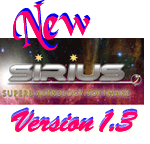Just Released; The New SIRIUS 1.3

NEW FEATURES OF SIRIUS 1.3
Listed below are new features of Sirius 1.3.
Last week we attended the United Astrology Conference (UAC) in New Orleans, the world's largest astrology conference. We met many of you, learned a great deal about new developments in astrology, and got lots of ideas on directions for our software in the future.
The great breadth of calculations provided in Kepler and Sirius is being used by many astrologers. For example, in Bill Meridian's lecture on eclipses he emphasized that Sirius provides the features he needs. Ben Dykes described a form of primary directions known as circumambulations with a feature he refers to as partner planets, and this calculation was put in Sirius a few years ago but Ben and many other astrologers were unaware of these capabilities.
NEW FEATURES OF SIRIUS 1.3:
Expanded Atlas and Database of Famous People:
The number of cities has increased from about 350,000 in Sirius 1.2 to over 900,000 places in Sirius 1.3. Note that the commonly used ACS Atlas in most astrology software has about 260,000 places. The ACS Atlas is comprehensive for the United States, but is missing significant towns and cities with tens of thousands of people in some countries.
The number of charts in the database of famous people has been expanded to be over 80,000.
- Parallels and contra-parallels in geocentric latitude and heliocentric latitude can now be included in interpretations, AstroSignatures and AstroSignature Forecasts.
- New AstroMap Feature:
An AstroMap with the "Just Lines" format with the In Mundo selection can now have the midpoints to the Ascendant be parallels of altitude, which means that one planet is above the horizon by the same amount the other planet is below the horizon. This is a true in mundo midpoint to the Asc. This feature was also added to Sirius 1.2 in mid March, 2012 so owners of Sirius 1.2 also now have this feature as well, and can get this feature by installing the free update to Sirius 1.2 if they purchased Sirius 1.2 before mid March.
- Direct Distance Composite:
In most astrological work, the zodiac positions of the planets are used and the distance between planets is measured along the ecliptic plane rather than directly between the two planets. Some astrologers are now using direct distance measurement, or, in other words, the actual distance between planets. In Sirius 1.3 you can now produce a composite chart that is based on measuring the angular distances directly between the two planets rather than measured along the ecliptic plane.
- Improved Harmonic Highlights Report:
The Harmonic Highlights Report is a report included in both Kepler and Sirius. It is written by David Cochrane and it provides brief interpretations of minor aspects in the chart. In Sirius 1.3 the Harmonic Highlights Report also provides brief interpretations of planetary pictures, which are combinations of four planets in a symmetrical pattern called isosceles trapezoid. David Cochrane icon this name Isosceles trapezoid for 4 planets combinations.
- Kepler WorkShop (KWS):
Save the Transit Text Listing in RTF. The KWS main window is now movable and re-sizable, and graphs automatically adjust to the control size. Also, the Business Manager Clients Database ca be exported to Excel-importable plain text, and tab-separated file. The Chakra Text window displays the data for currently selected varga. Previously it was always for Rasi. Shad Bala is not affected by that much because it already uses 1, 4, 7 and 9 harmonics and some other than planetary positions factors.
- Eclipse Map:
Cities names added. Turn them on/off in Preferences
- Export data for three related charts:
This feature was added for a research project which compared the chart of the batter in a baseball game to the transits at the time of the game and to the pitcher of the game in which the batter hit a home run. In this research project it is hypothesized that the performance of the batter is affected by the transits at the time of the game and the chart of the opposing pitcher. This is an intuitively reasonably assumption and the ability to export the three related charts for use in a statistical analysis software is a helpful advanced feature for researchers.
- Ability to select specific planets in the Asteroids Map.
- Added solar and lunar returns to the progressed chart, which are known as kinetic returns by some astrologers.


